Toyota has already shown that electric motor technology has matured a lot and can offer clear advantages.
Having a hybrid in the B-segment may seem like a risky bet, mainly because such systems raise the price of the car. However, the Yaris Hybrid seeks to bring this technology to all those people who do not mind spending a little more at the time of buying the car, because then it is true that in the long run it can be more than compensated. Of course, to achieve this you have to be methodical and, especially, a driver whose priority is to move around the city. It's funny, but the Yaris Hybrid uses the least amount of fuel in the urban jungle.
The Yaris Hybrid range starts at 15,490 euros with the City trim, almost 2,300 euros more than its 100 hp petrol equivalent. If you are looking for one like the tested unit, with Feel! finish, you will have to pay 18,490 euros. The Toyota Touch 2 & GO navigator, Toyota Safety Sense pack and Classic Red paint are the options that equipped the tested unit, costing 600 euros the first two and 200 euros the last. It may seem expensive, but you have to take into account the technology and equipment. A Volkswagen Polo, with similar equipment, 90 hp and DSG automatic gearbox is around 20,000 euros...
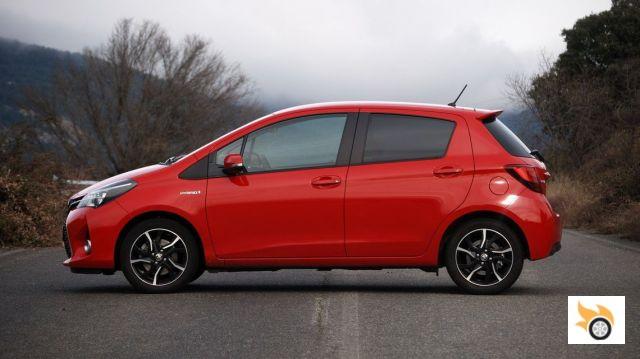
Design
The current generation of the Toyota Yaris was introduced way back in 2011 (2012 the hybrid), although in 2014 it received a fairly thorough redesign. Many will say it was just a slight restyling (I thought so myself), but the truth is that Toyota changed more than a thousand parts. The pre-styling Toyota Yaris Hybrid was aesthetically different, and very much so, from the non-hybrid Yaris. Now the Hybrid only differs from the rest by very specific details, such as the Toyota emblems with blue background and the badges on the front wings and trunk door that give away its hybrid status.
It was the Toyota Aygo, the smallest of the brand, in charge of premiering the new image of the front in Xs. This design guide, dubbed "JPlayful", is a nod to Japanese youth culture and is a step change, which is making its way across the range. It mainly aims to appeal to a younger audience and does so with a modern, casual look. In the case of the Yaris, it is a little more sober than its little brother, as it also seeks to appeal to the European public.
Until recently no one bought a Toyota because they loved its design, but now it's not so bad. The changes that were made in the facelift were not that huge, but the front with the shape of a cross is cool. In fact, it's the front that is most striking, which defines the shape of a fairly large bumper for what are the dimensions of the car: 3,950 mm long, 1,695 mm wide and 1,510 mm high.
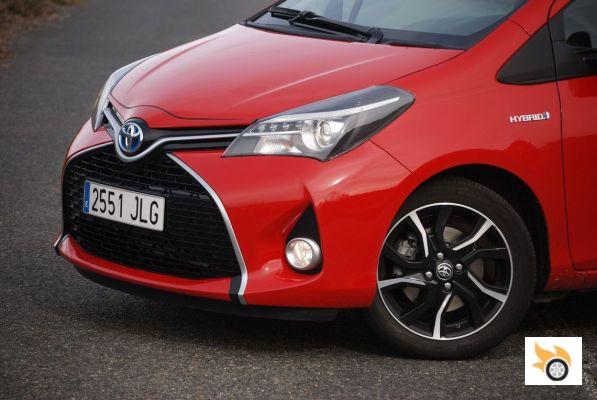
A single piece collects the grille, the main grille and the emblem. This part integrates the number plate without the need for plates or other surfaces that spoil the front.
But everything has a reason, and the lower part of the grille is this big to better cool the electrical systems. However, it should be noted that Toyota's hybrids are excessively cooled, which is why the ecoflaps (radiator capping in order to save fuel by reducing heat loss) were developed. A spoiler at the bottom of the grille in the body color and a chrome strip at mid-height, joining the headlights with black background and LED daytime running lights, give the small urbanite a certain aggressiveness that it didn't have before.
The side is the most sober area of the Yaris Hybrid. The 16-inch wheels (the largest that can be equipped) with two-tone tires 195/50, corresponding to the Feel! finish, are sheltered in a fairly discreet wheel arches. And it is in the wheel arches where we also find the "Hybrid" emblem. Finally, mention the rising ribs that run along both sides, one in the lower area and another across the door handles. It is a detail that helps to create a sense of dynamism and a better packaging of the overall appearance.
The rear is perhaps the least changed from the pre-styling model. Its design is clean, without many frills. The reflectors are located in the lower area of the bumper, a black plastic area that contrasts with the bodywork, unless the car is light black. The headlights, being able to be LED, have some graphics and a relief that make them more "nice" than before. Although this is not a sporty car (nor is it intended to be), it does have details that give it that appearance. Some of these details are the aforementioned front and side ribs, in addition to the discreet spoiler located at the top of the tailgate, which integrates the third brake light. The exhaust pipe is well concealed, it is not something that any hybrid of the brand flaunts.
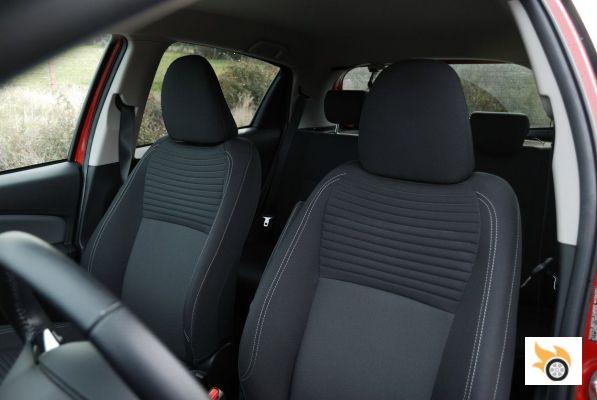
Cabin
When we enter the cabin of the Yaris Hybrid we realize that the perceived quality is quite good, although perhaps not as good as the last batch of its competitors. Toyota has always stood out for its good fit and robust materials that stand the test of time, but it is logical if we take into account the years with which the initial "base" counts. There are still harder black plastics with a less pleasant texture in many places (especially at the rear), but we must not forget that this is a general utility car and does not seek a premium character. However, in the most visible areas of the dashboard are soft plastics (of a lighter color), in addition to other materials with a more pleasant feel.
In the case of the instrumentation, we see that the dashboard is different from that of a non-hybrid car. We find a table consisting of three clocks, the large central one with the speed, on the right a fuel gauge (also quite large) and on the left the evidence that we are facing the hybrid version, a potentiometer dial containing the CHG, ECO and PWR indicators. The first one indicates energy recovery and we will only see the needle there when we decelerate or when we have the gear lever in position "B" (hold). The second one indicates that our driving is efficient. The last indicator means that we are asking for maximum power and the combustion engine will therefore rotate at maximum speed to offer the quickest response. To display the battery charge level and other battery information, such as the energy distribution of the engines, we will have to go to the central display.
Inside the dashboard we have a small blue backlit LCD screen, which has nothing to do with the 4.2-inch color screen that appears in its big brother, the Toyota Auris Hybrid. It's a detail that looks rather old-fashioned, and even more so knowing that to change the on-board computer data you have to put your hand inside the steering wheel rim.
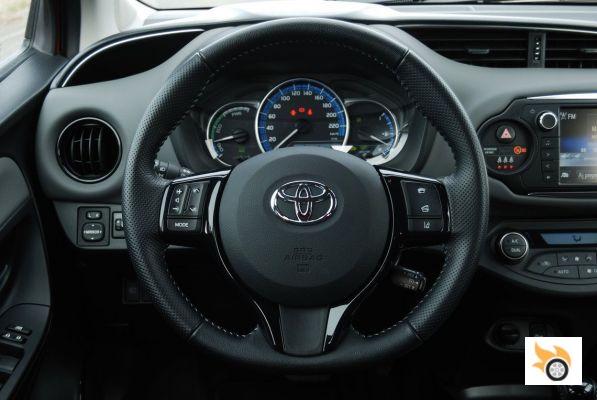
The steering wheel, in this trim, is covered in perforated leather and is multifunction. It is height and depth adjustable, so finding a comfortable driving position is relatively easy. Some drivers may feel that the steering wheel is too close to the dashboard. The steering wheel allows you to control the phone and multimedia system in a fairly intuitive way. A little hidden behind the rim, at the bottom right, is the cruise control.
The center console is dominated by a 7-inch touchscreen, standard across the Hybrid range except for the City trim, which includes graphical information from the hybrid system, bluetooth connectivity and, of course, the multimedia system. It's not the fastest or smoothest screen on the market, but it performs with dignity. Just below it are the controls for the dual-zone climate control, next to the start button. And below this are the USB port, the 12V power socket and storage compartments. In this last area a small courtesy light would be useful, especially to find the USB socket in poor light conditions.
Although the central tunnel has changed with respect to the previous model, raising it higher and shortening the gear lever, the latter is still quite bulky. It is still a clunky, with marked routes, which in a car of this type is unnecessary. It is comfortable to use, I will not deny it, but aesthetically it is quite ugly and could have been better resolved through a small joystick type lever as equipped with the Prius or Auris Hybrid. Between the front seats, very hidden, under the handbrake, are the "electric mode" (EV) and "economy mode" (ECO) buttons, which I'll talk about later.
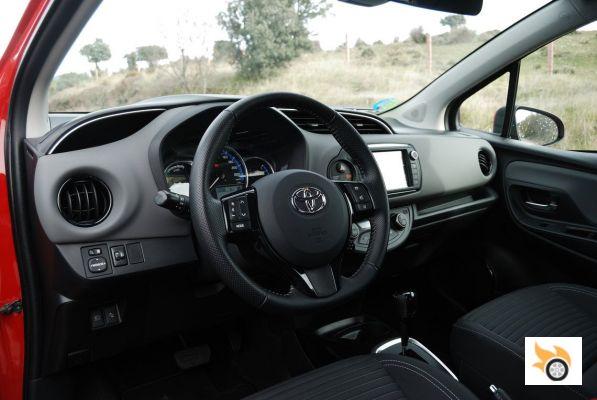
Moving on to the subject of storage spaces, the Yaris has a few, at least in the front, because there's no storage space in the back; there are no door pockets. Behind the handbrake there's a space for a bottle and a slightly larger one. To the left of the steering wheel, above the ventilation nozzle, there is a perfect place to keep the "key" of the car, the mobile, the wallet or objects that are not very bulky. In the front doors, the lower bags are perfect for carrying half-liter bottles, as they fit quite well and are quite wide if you want to deposit more things. In front of the gearshift lever, there is a narrower hole, and two more with rounded shapes ideal for placing a couple of bottles. The glove box is correct, no more.
The B-segment doesn't stand out for its interior space. With a wheelbase of 2.51 metres we can't expect a surprising amount of roominess, although the Japanese brand has solved this issue quite well and outperforms some of its rivals in this aspect. As you would expect, in the front seats there is no problem at all, it's very easy to find a satisfactory driving position. They're quite spacious and comfortable, as well as being comfortable. The seats in this finish are mixed, leather and fabric, very good looking for the car that is.
Already in the rear seats things change. In the case of the Yaris, the headroom and knee room is quite good. A person of 5'9" feels comfortable in the back. In fact, that same person confessed to me that she felt more comfortable in the back seats of the Yaris than in her first-generation Touran. The narrow width of the seats is what will make it quite difficult to seat five adults.
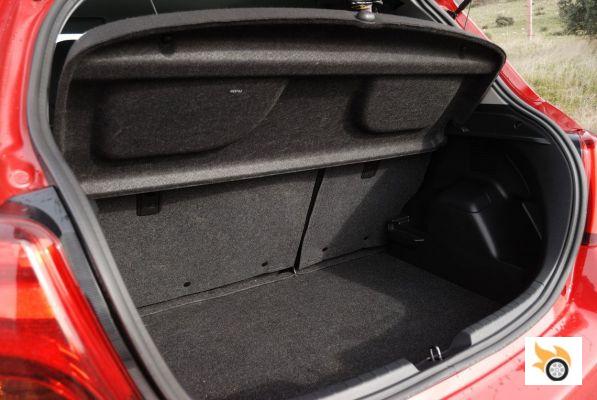
The seatbelt in the third rear seat hangs from the roof, and is a three-point seatbelt with two anchors. It's a seat more suitable for children or teenagers, for adults it's a bit tighter. The backrest is not hard, but there is not enough room for the feet, nor is there enough room for the back. Its size gives what it gives.
Despite being a hybrid model with fairly large batteries, the trunk does not vary from its non-hybrid siblings. It remains at a respectable - but not remarkable - 286 liters. Its regular shapes make it quite usable. If we want a little more space, there is a double bottom that slightly increases its usefulness. If we need more space, we can fold down the seats asymmetrically obtaining a virtually flat surface increasing the capacity to 768 liters. It misses some hook to hang bags or some kind of hook to hold the load. Under the carpet of the trunk we will only see a puncture repair kit, as in all versions of the Yaris range.
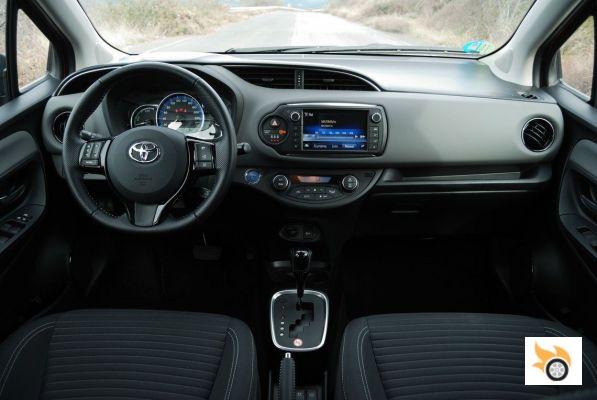
Equipment
Since its restyling in 2014, the hybrid engine no longer has to be necessarily linked to the two highest finishes, but can be chosen in both City, Active, Feel!, Feel! Bi-tone and Advance, the same as the rest of the range. The most basic, the Yaris City, has 15-inch steel wheels with hubcaps, dual zone climate control, on-board computer, electric front windows, two-tone fabric upholstery, halogen headlights, hill start assist, daytime running lights, USB input, 6-speaker CD radio with Bluetooth hands-free and numerous safety systems (ABS, EBD, traction control, stability control and seven airbags). It starts at 15,490 euros.
The Active trim adds 15-inch alloy wheels, double tray in the boot, seven-inch touchscreen, Bluetooth hands-free, iPad-compatible USB socket, cruise control, fog lights, rear-view camera, LED rear lights, push-button start, electric windows front and rear, steering wheel controls and leather-wrapped steering wheel and gear lever. It starts from 16,490 euros. The Feel! is the finish more focused on the young public, and the one of the tested unit. It adds to the Active the 16-inch two-tone wheels, beehive-type front grille, mixed upholstery, LED daytime running lights, tinted glass, rear spoiler with integrated brake light and armrest for the driver. It starts from 17,090 euros.
The Feel! Bi-tone only differs from the Feel! in the possibility of color selection, being able to be Bi-tone Grey, Bi-tone White or Bi-tone Red, being always the second color black. The top of the range, the Advance, differs on the outside by the grille with piano black finish, 16" wheels, lower light in the passenger compartment area, electrically folding exterior mirrors, light and rain sensor, electrochromatic interior mirror, keyless entry and start system and fabric and Alcantara upholstery. It starts at 18,190 euros.
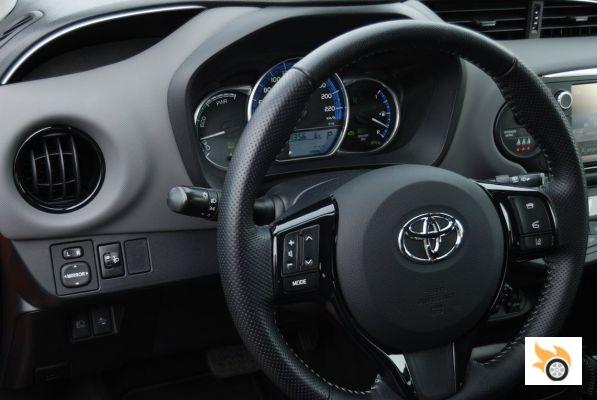
Among the optional we find colors ranging from 200 euros (Classic Red and Classic White), to 800 euros (Bi-tone Grey, only available in the finish Feel! Bi-tone), through 400 euros (Graphite Grey, Blue Kallfü, Electric Blue and Meteor Grey) and 600 euros (Glacier White and Tokyo Red).
In the City and Active trims we can also opt for various 15-inch wheels in different colors ranging from 552 euros to 765 euros while, in the finishes Feel!, Feel! Bi-tone and Active, we will find only 16-inch wheels that, depending on the finish, will vary between 813 euros and 861 euros. The sunroof, available only on the Feel!, Feel! Bi-tone, and Advance, is 500 euros.
In all trim lines can be equipped Toyota Safety Sense system (600 euros), which includes pre-collision warning system, warning of involuntary lane change and automatic road light manager. The Toyota touch 2 & GO system (600 euros) can also be fitted on all versions except the City trim. This includes navigation system, advanced Bluetooth connectivity, access to pre-installed applications, and emergency call and assistance. It is not prepared for either Android Auto or Apple CarPlay.
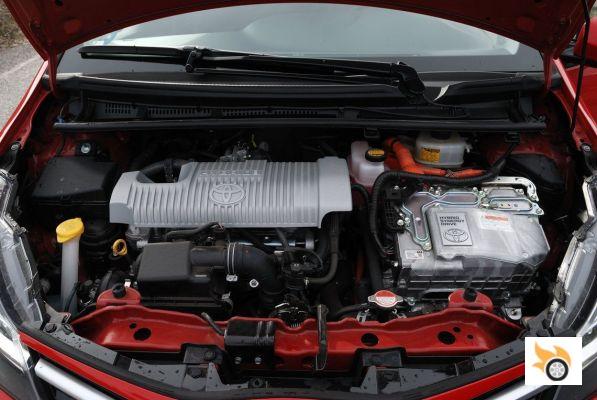
Technical
The Toyota Yaris has the honour of being the car with a petrol engine that consumes the least amount of dinosaur juice according to the NEDC approval cycles, except for plug-in hybrids. This is achieved through a low weight (1,085 kg without driver, with a full tank), a very efficient powertrain and a body with good aerodynamics (Cx of 0.29). Its official fuel consumption is only 3.3 litres per 100 kilometres, although this figure is only achieved with the versions fitted with the 15-inch wheels; this version is rated at 3.6 l/100 km.
The engine is based on the four-cylinder 1.5 VVT-i Atkinson cycle of the second-generation Prius (1NZ-FXE), in turn inherited from the first-generation Yaris. But, although it starts from that block, the vast majority of its components have been suitably updated (70% of them compared to the pre-styling model). It is also based on the electrical system and third-generation Prius batteries, which in turn are the same as those of the current Auris Hybrid, making the components more compact and lighter. There's no space to spare in the Yaris, and they couldn't make it much fatter either.
It can run on electric power, just the petrol engine, or both. The electric power is produced by a nickel-metal hydride battery, which is cheaper than the lithium-ion batteries used in other Yaris models. In terms of power, the petrol engine produces 75 hp at 4,800 RPM and offers 111 Nm, but when added to the set it reaches 101 hp. The transmission is Toyota's well-known e-CVT, which I'll talk about later. Performance is not surprising, with a top speed of 165 km/h and a 0-100 km/h that takes 11.8 seconds. It's not looking for sporty sensations or high performance, but for comfort, refinement and maximum efficiency.
It's worth mentioning that 0-50 km/h takes just 4 seconds, and 80-120 km/h takes just 10 seconds, which is not bad at all. Its e-CVT automatic transmission doesn't transmit any sportiness, nothing at all, but the needle on the speedometer moves faster than it looks, although after 100 km/h it's hard to pick up the pace. Believe it or not, the Yaris Hybrid is the most powerful option in the Yaris range, waiting for the confirmed 210 hp Yaris "GTi". Below that there are two petrol options: the Yaris 70, with a 69bhp 1.0-litre three-cylinder, and the Yaris 100, with a 99bhp 1.3-litre four-cylinder. Both come with a manual gearbox, the smaller one with five speeds and the other with six. The 99 PS can be fitted with a seven-speed Multidrive automatic transmission.
The 90 PS 1.4 D-4D is perhaps the most direct rival within the Yaris range itself, as the Hybrid has very similar performance to the Yaris 100. The petrol car covers 0-100 km/h a second faster, and the top speed is 175 km/h with 0.5 litres more fuel consumption per hundred kilometres. However, it is the least demanded engine of the Yaris range. The hybrid, in addition to having the lowest consumption on paper, we must remember that the maintenance cost of this mechanics is really low, since it lacks clutch, starter motor, alternator and corresponding gears and belts.
The e-CVT gearbox, or electric continuously variable transmission, keeps the engine always at its optimum rotation. It does not require gears, but is based on pulleys, so that the speed increase is constant and jerk-free. The operation of the engine is much more efficient, because in this case there is no fixed number of ratios and it maintains the engine torque and power, thus avoiding excessive revs. The result? Less fuel consumption, greater comfort and lower emissions. The "e" means that the usual torque and speed conversion function is performed by an electric motor, not the traditional belts.
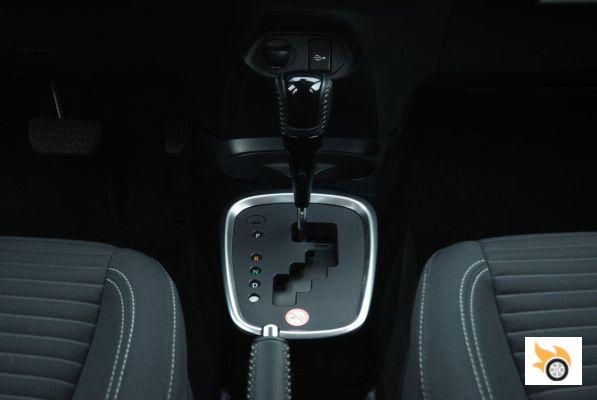
The Yaris Hybrid's unobtrusive gear lever has five positions: P, R, N, D and B. The latter is a program that artificially retains the engine, slowing it down and recovering energy, but also revving it more and, consequently, generating a high noise that can be annoying in the passenger compartment. It's the right program to prevent the engine from bogging down a mountain pass, practically useless (because it's inefficient) in any other circumstances.
The front suspension is of the McPherson type with coil spring, the rear suspension is of the wheel type with torsional element (rigid axle). The setting of the suspension gives priority to comfort over anything else. In this sense it is like the rest of the cars in its category.
The test unit was fitted with Bridgestone Ecopia tyres. They fit 195/50 R16 84 V and had just under 12,400 kilometres on them when I picked it up. The brakes, for their intended use (100,000 km of brake pad life according to Toyota) are more than adequate. If the driver makes an effort to use the regenerative braking and is proactive, the pads can easily exceed that barrier.
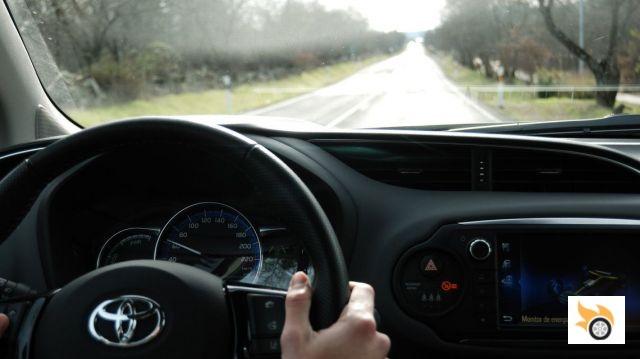
Driving
This car, like all hybrids, is all about efficiency. It's not an autonomous car, you'll have to help it. How? By being extremely gentle with your right foot and always bearing in mind that, if you want to tackle certain hills or go a little lighter, the internal combustion engine will have to turn (and consume) with more joy. But let's start with the first thing, which is getting into the car. The driving position of the Yaris offers good levels of comfort. You quickly find the right position for the pedals, seat and steering wheel. The cockpit has been designed so that all areas are within easy reach, including the multimedia system.
The first question that comes to mind is when the car is started. A first touch of the start button activates the ignition, allowing you to operate all the car's functions, but without moving it. If you want to start the car, you have to press the brake pedal and press the button again. If you don't press the pedal, a warning light on the instrument panel will remind you. And even then, sometimes it won't start if you don't get it right the first time. On several occasions I have to admit that I felt trolled by the car, or that I am very clumsy, which can also be the case.
When you see the word "READY" illuminating on the display, it means that the car is ready to move. You can't hear anything, absolute silence. We remove the handbrake, put the gear lever in position "D" and accelerate to check how we move in electric mode. The first sensation is gratifying, driving in silence and without wasting a drop of petrol. That feeling comes to an end when we demand a little more power to the engine, in my case in just 10 meters to climb the ramps of the garage.
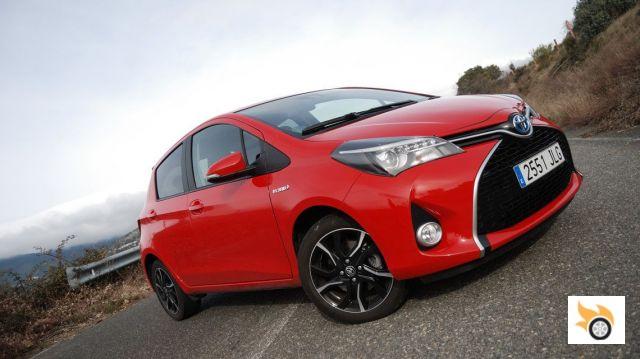
The little hybrid, whenever it can, will try to work in electric mode, although to do so it is not necessary to exceed half of the potentiometer. And sometimes it's hard, but if you're very careful with the accelerator pedal and the conditions are right, you'll be able to drive up to 60-70 km/h in pure electric mode. With manual selection of electric mode (by pressing the "EV" button) it will always run in electric mode, although you'll only last two or three kilometres. Why so few kilometres? It's not intended to do more. To fill the battery completely, you'd have to be continuously descending gradients of more than 5%. And that's because the electric motor is always working, not just during acceleration or low speeds. In EV mode the maximum speed (without the combustion engine being activated) is lower but, in return, the available acceleration is higher without the 1.5 engine being switched on.
With the "ECO" mode the accelerator becomes a little more sluggish in its response and the air conditioning gives less air flow, always in favor of wasting as little energy as possible.
You won't find any petrol or diesel car that is quieter than this one. We will only hear the engine (and quite a lot) when we ask for maximum power, but in a stable road regime we will hear more rolling noise and aerodynamic resistance than anything else. In the city it can go unnoticed by pedestrians, I can attest to that. One thing that is very well achieved is the jump between engines. It is hardly noticeable, if at all, to know when it is working in purely electric mode or working together with the petrol engine. You'll only notice it if you glance at the power indicator or the data on the central display. You can tell that the brand has done a great job in terms of soundproofing the cabin and also in terms of engine refinement.
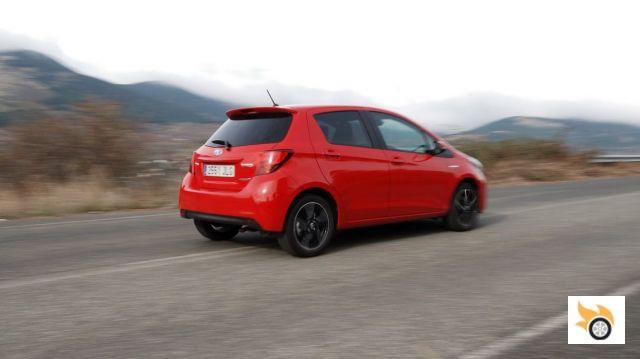
It is not a dynamic car. In terms of chassis, Toyota has opted for a perhaps too soft setting, with a not very communicative steering and shock absorbers with too much travel, which means a great balance if you face tight corners a little bit forced. In intense braking, where the ABS jumps, the car suffers from intense head bobbing, getting to worry. It's not that it's going to fall or lift off the ground, but the inertias are greater than one would expect. The soft suspension is also very noticeable in speed bumps and potholes, where it is dry but the high travel is appreciated.
The steering is uninformative and with almost no feedback. The steering wheel is large, and when you first turn it, you'll have to turn it more than you thought you'd need to. It's almost three turns between stops. Another detail about the steering: according to the car's data sheet, the turning diameter between kerbs is 11 meters, and it's noticeable, very noticeable. For a city car its turning diameter is enormous. It's huge even for the upper segment. Most of its rivals barely need 10 to 10 with little meters, some lowering that figure, being the Mazda 2 the leader with 9.4 meters between curbs.
Regarding the e-CVT gearbox, as I mentioned before, it's very progressive. Acceleration is not overwhelming, especially from 100 km / h, where the engine revs a lot and we will notice that the car gains speed, but very quietly. In this case, you could apply the saying "much ado about nothing". If you have to overtake on a secondary road, you will have to anticipate the manoeuvre in order to do it safely. It's not a car for touring and cornering, there's nothing sporty about it, but that's not the aim of this car either.
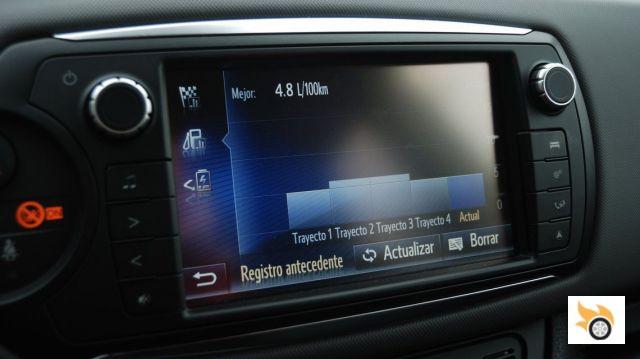
I finish with one of the positive points of the Japanese hybrid: its consumption. It's relatively easy to average around 5 litres per 100 kilometres, although it will be lower the more we drive in the city. The average consumption during the test was 5.3 l/100 km after 620 km in city and open road conditions, in traffic jams, in the dry and in the rain.
In the city, the electric motor is more than enough and makes consumption ridiculous, as long as the batteries have a minimum charge and we do not ask the car more than 26 hp. If we go out on the road, its major shortcomings will come out. Unless you drive mostly downhill, consumption will hardly go below 6 liters per 100 kilometers, and over 7 is not outrageous depending on the conditions. However, doing more than 500 kilometers before the reserve is easily done. It's also worth mentioning that driving the car without hardly touching the open road can increase the range enormously. It may not sound like much, but the tank only has a capacity of 36 litres.
Raising the potentiometer needle above half of the same inevitably means asking for more power to the petrol engine and that it is more thirsty, within how little it spends.
It is a very sensitive car and the consumption will vary a lot depending on how heavy your right foot is. That's why doing an internet search on the consumption of this car the results are so varied. If you are gentle with the pedal and try to stay as long as possible in the ECO zone, both the car and your pocket will thank you.
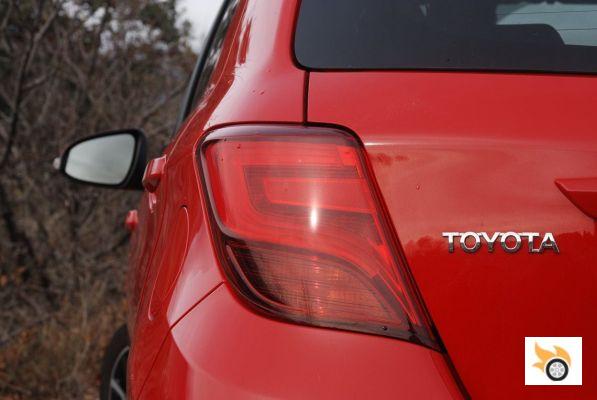
Conclusions
With only the Suzuki Baleno SHVS as a rival in the city segment, Toyota makes the Yaris Hybrid an almost unique car. At the beginning of the test I was a bit skeptical about this car. After a week of using it every day and being able to understand its philosophy, I actually liked it.
It's not a car designed for petrolheads, like many of us who hang around these parts, that's for sure. Nor is it a car designed for long family trips. It's a car designed for the most common journeys. If you live and/or work in a big city, driving enjoyment takes a back seat. Traffic jams, detours, a lot of street driving... that's the perfect place for this car. And that's why the Yaris Hybrid is at home in the city: it's its natural habitat. Its size, smooth and quiet operation, the convenience of the automatic transmission and low fuel consumption make it the perfect everyday ally. It just needs to turn better.
This is an alternative to diesel engines, cleaner, more pleasant to drive and at a slightly higher price. It starts at 15,490 euros. Yes, maybe for that price it could have some details that could be improved such as certain interior plastics, but it is a generalist car with some time behind it. It's not cheap, but considering everything it offers and the savings it can make in the long term, it might not be that expensive either. And not only what the car offers, but also the advantages it brings, such as the ECO sticker that gives you more facilities when driving around the city -especially in Madrid and Barcelona- or being partially exempt from IVTM depending on the site. All you have to do is use the calculator and see if it's worth the money.
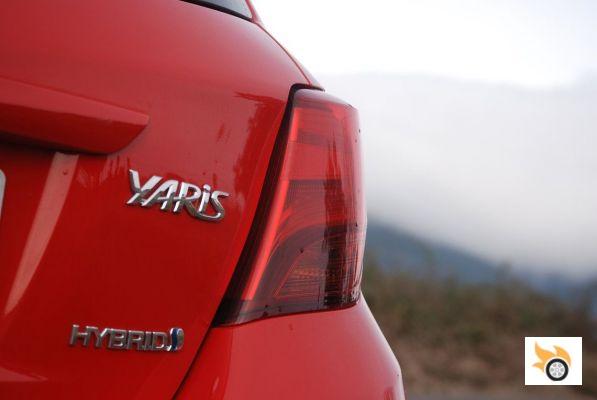
You can like more or less, but it is clear that it is a car that has its logic in the market. In fact, in 2016, of the 13,954 units that Toyota has sold of the Yaris in Spain, 5,987 correspond to the hybrid model. That means that it is the best-selling version by far, in second place are the gasoline, and the least sold is the diesel. The brand has made a great effort to sell more hybrids than diesel, and these are the results of its policy. It may be a foretaste of what's in store for the rest of the B-segment.

























